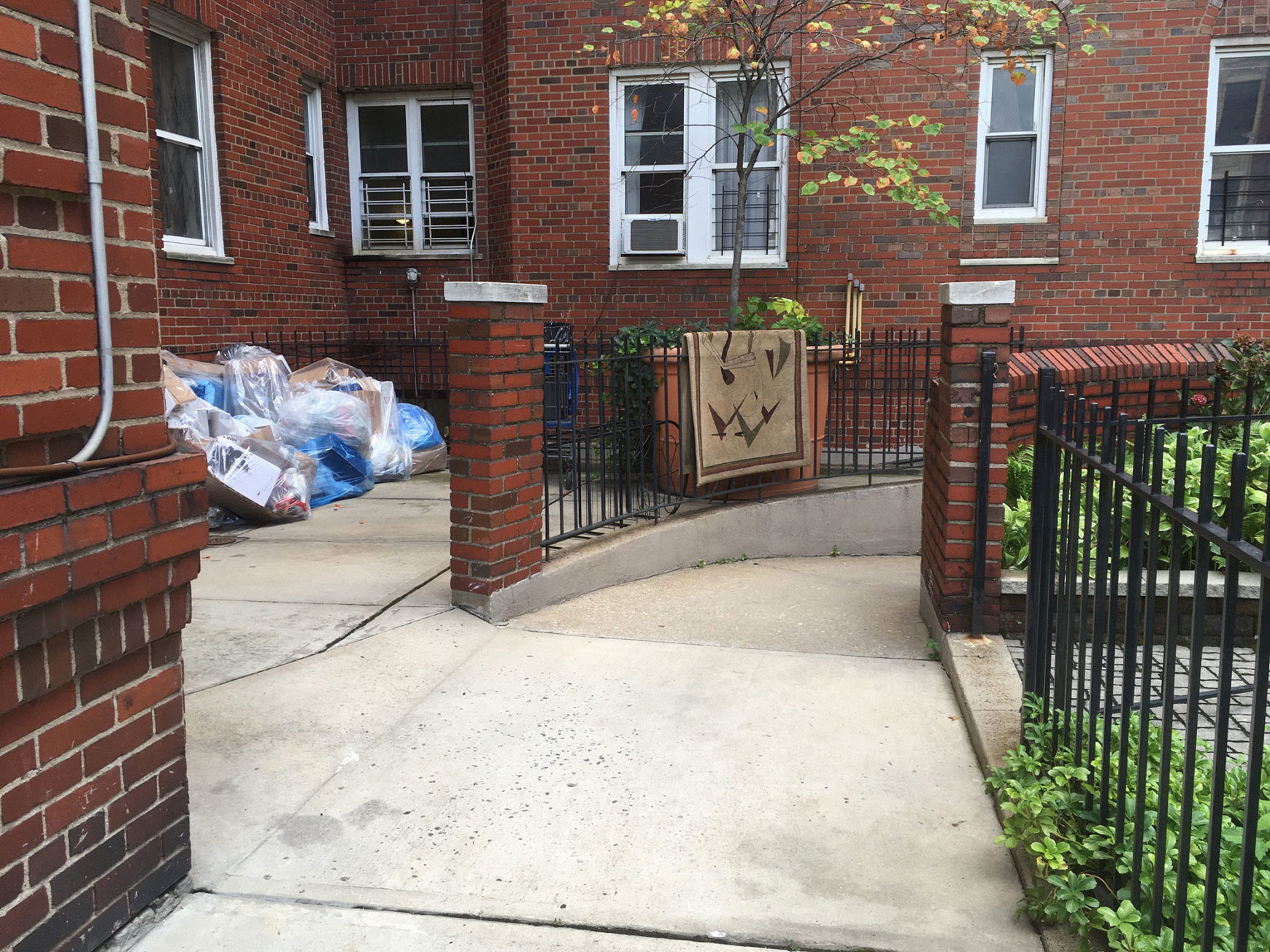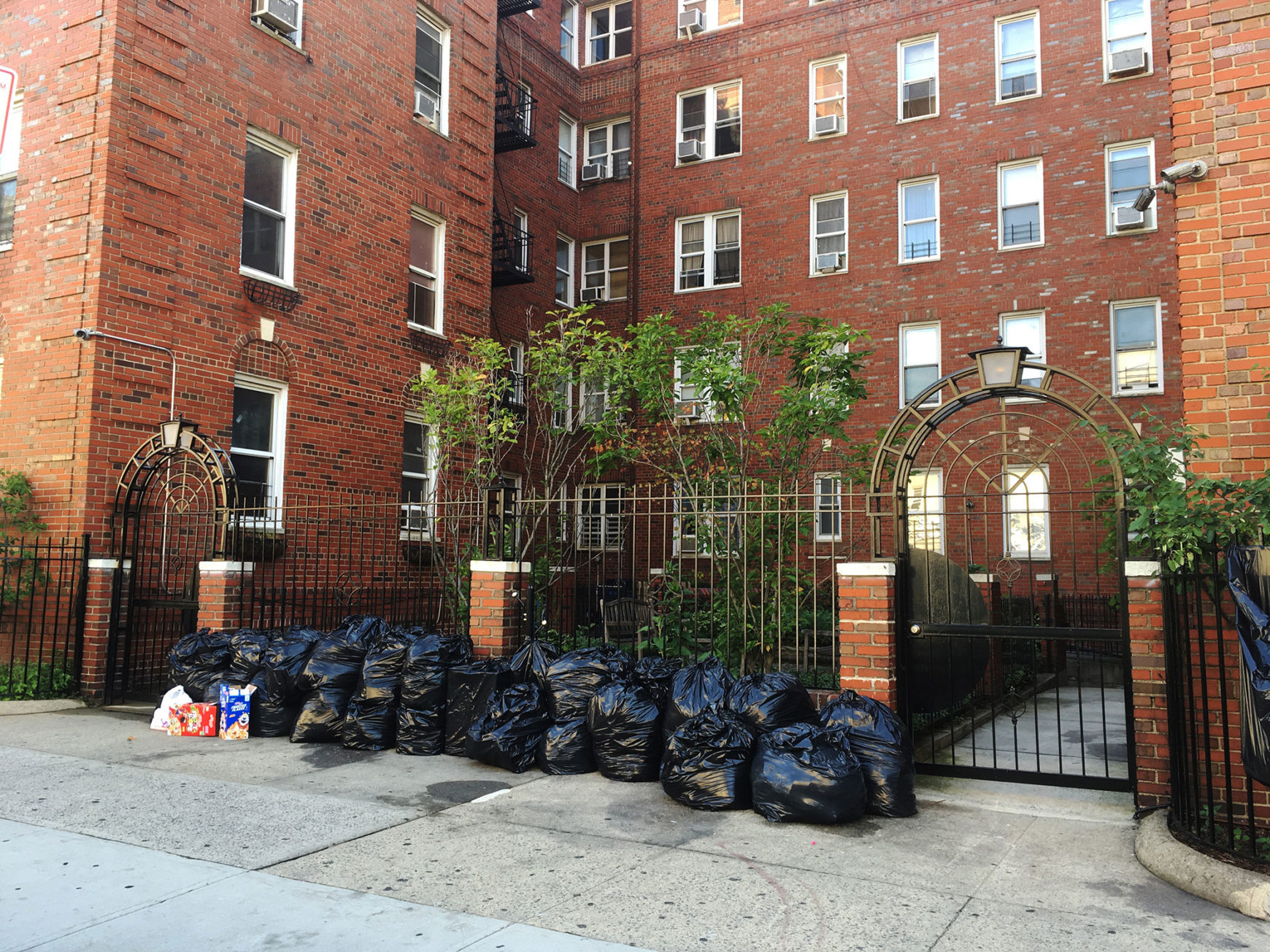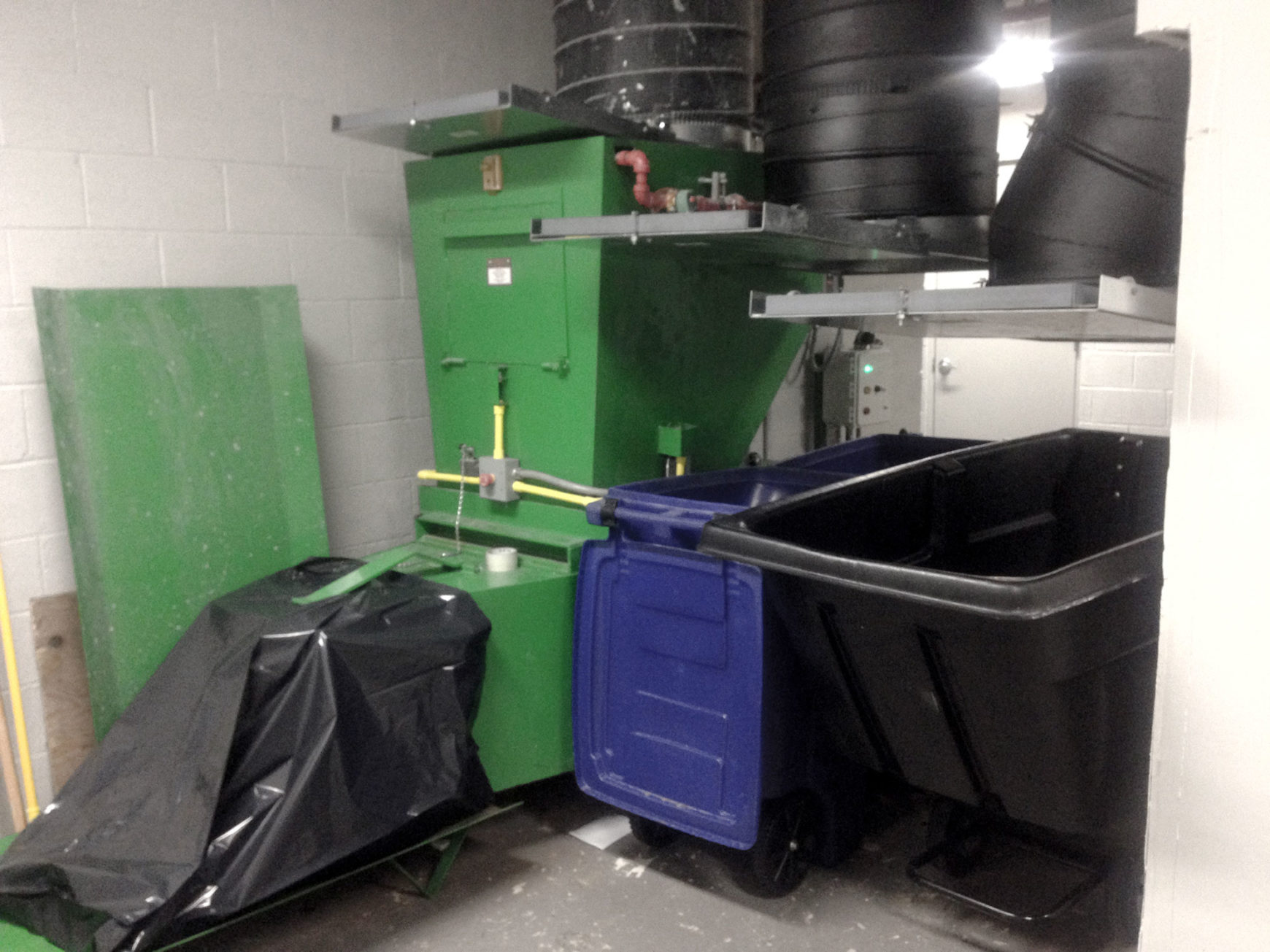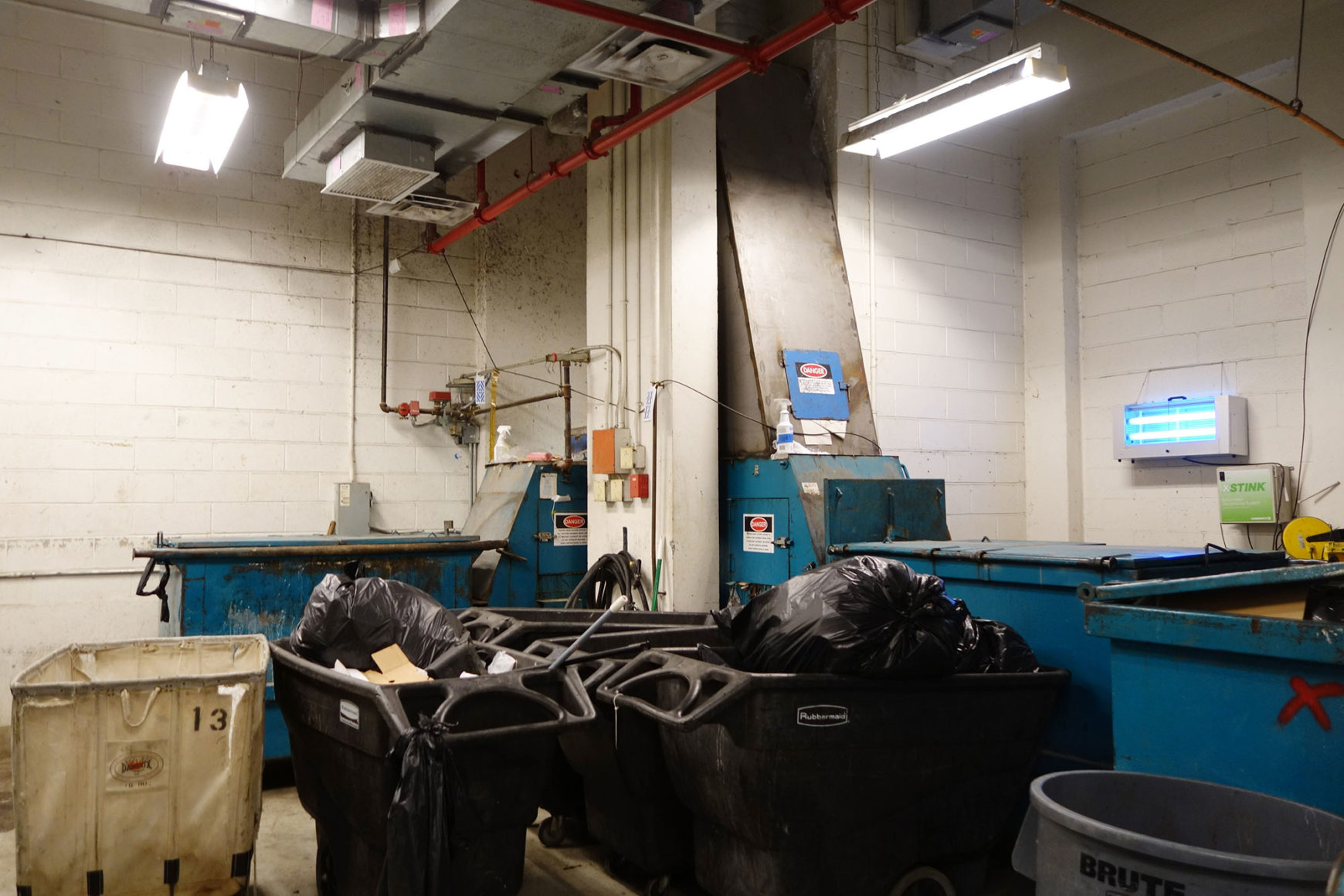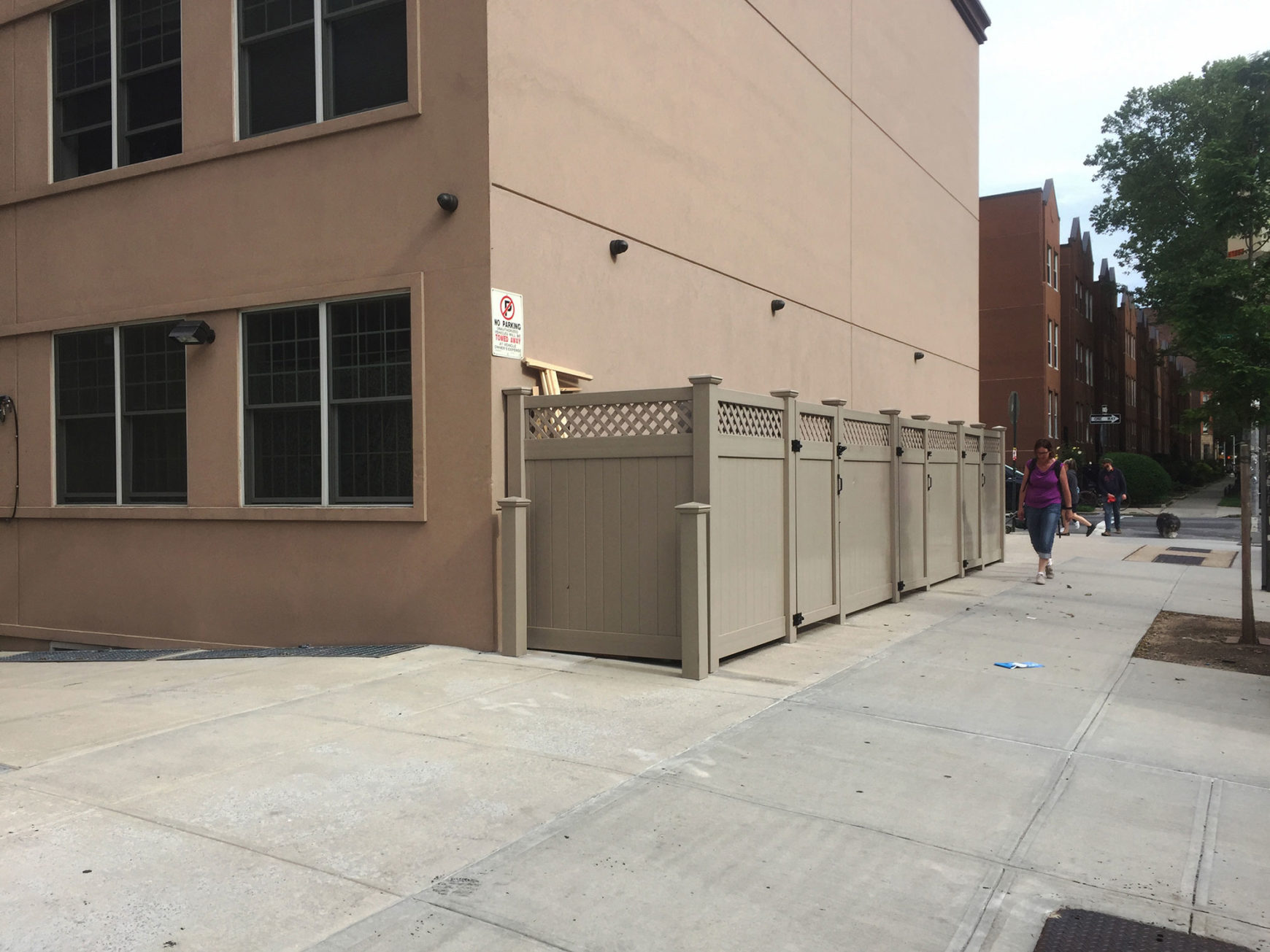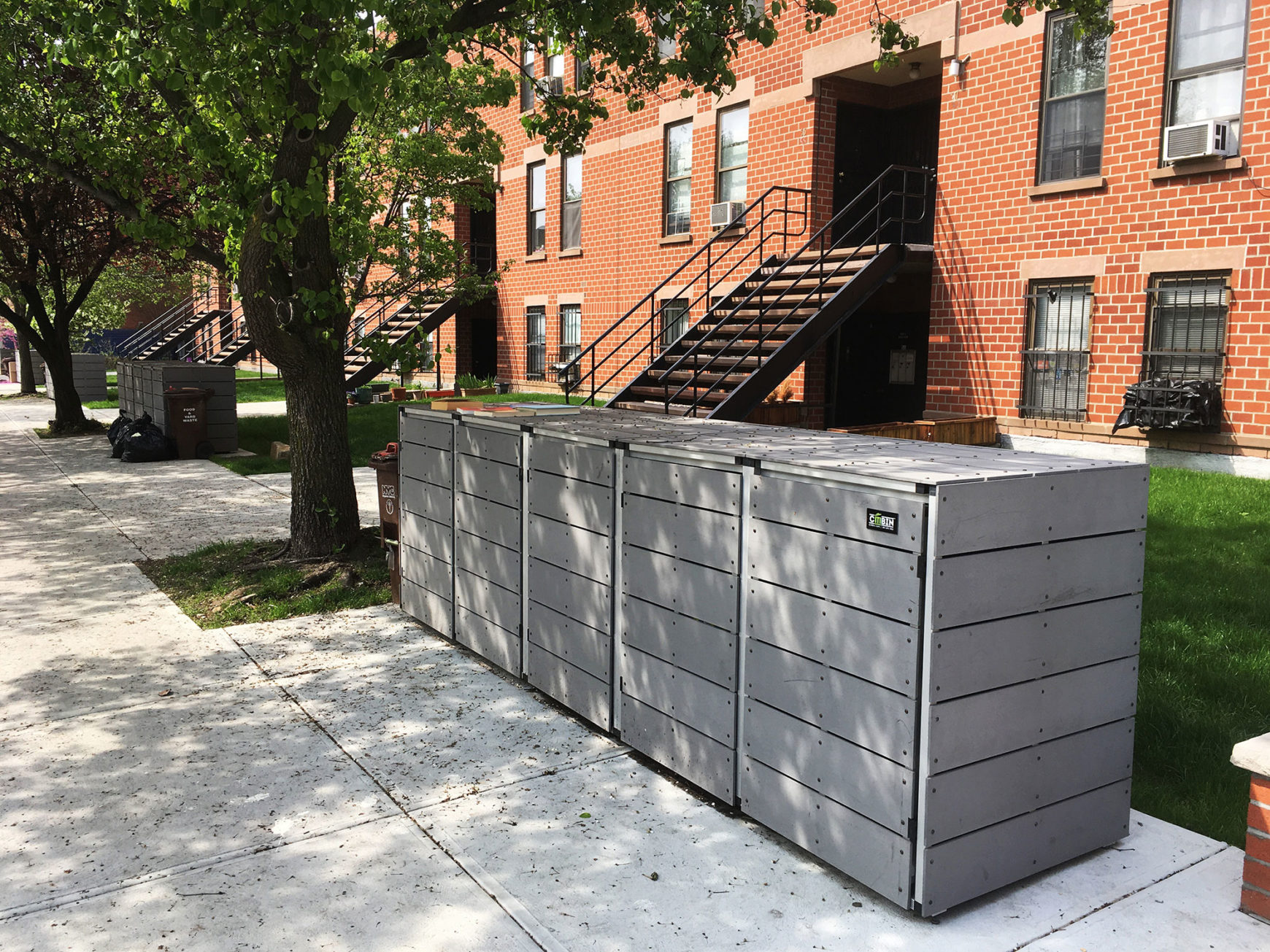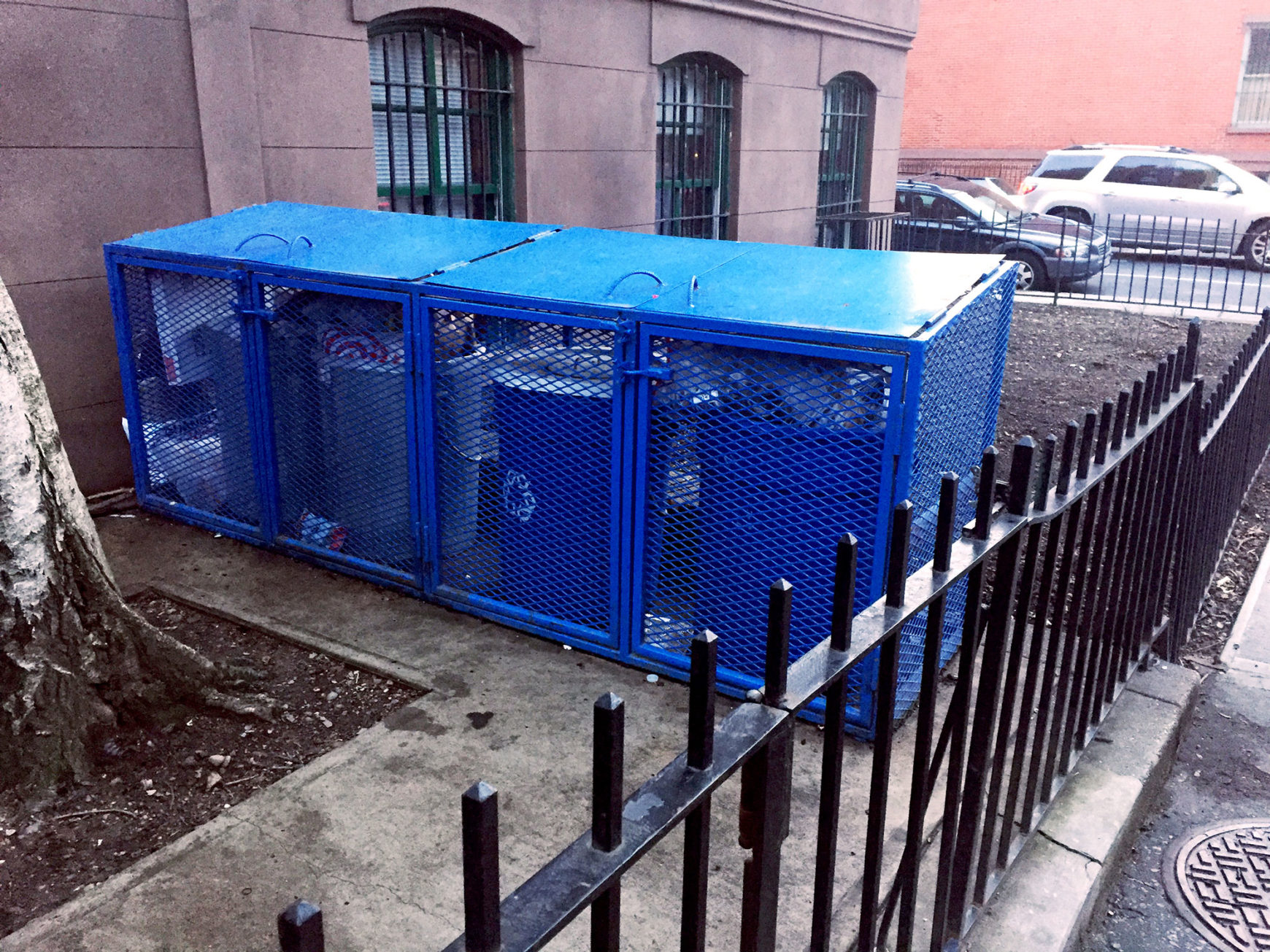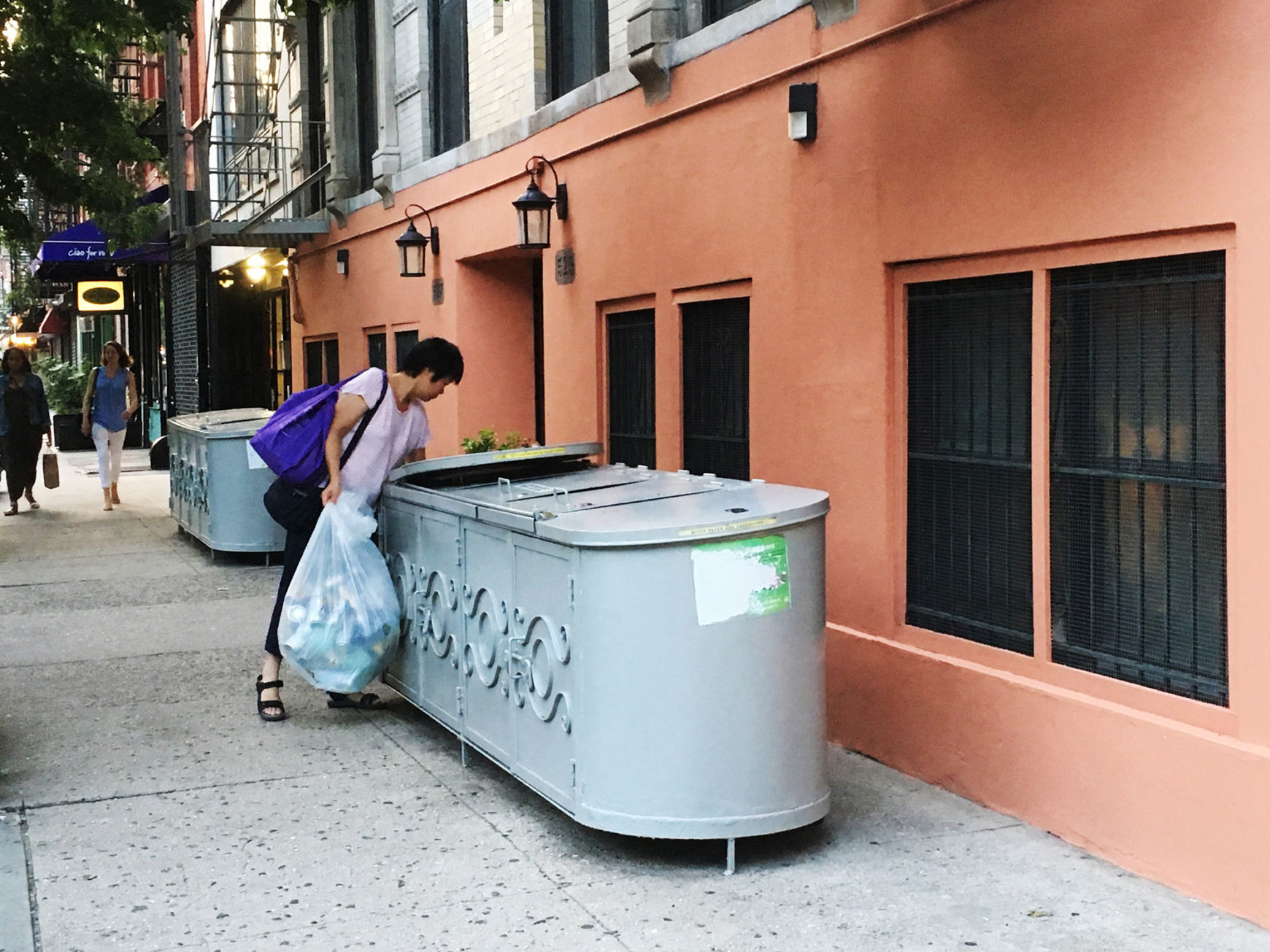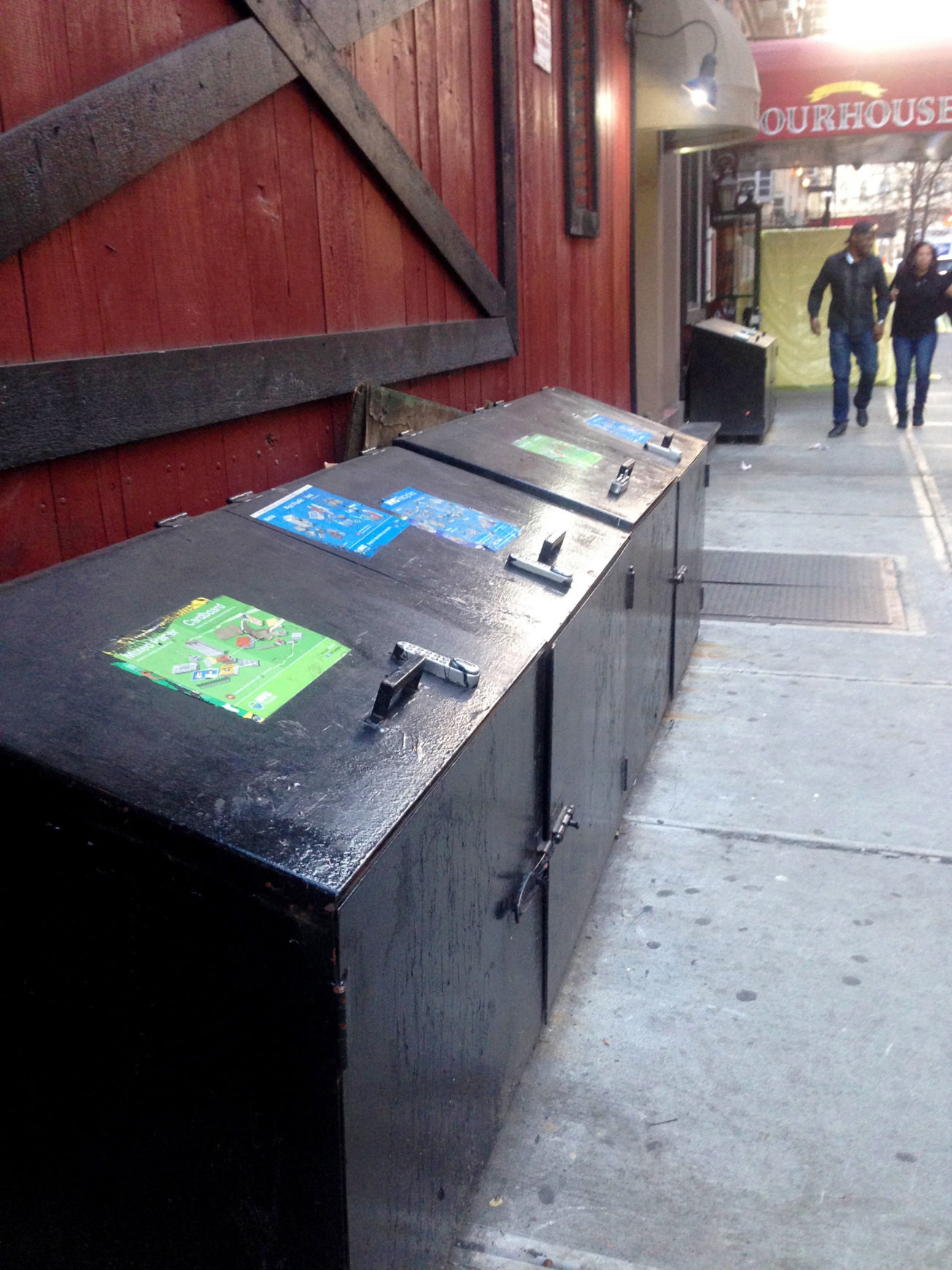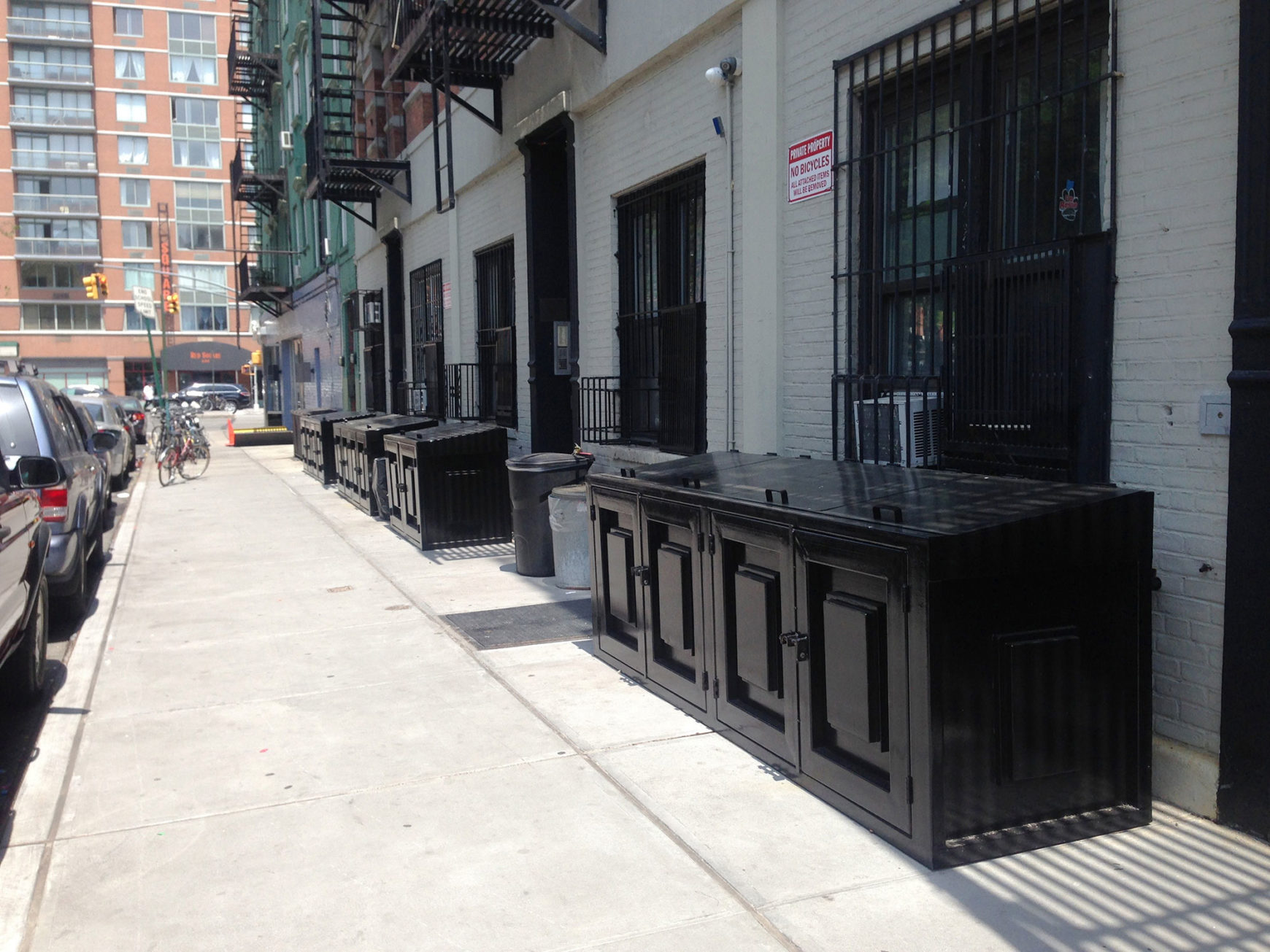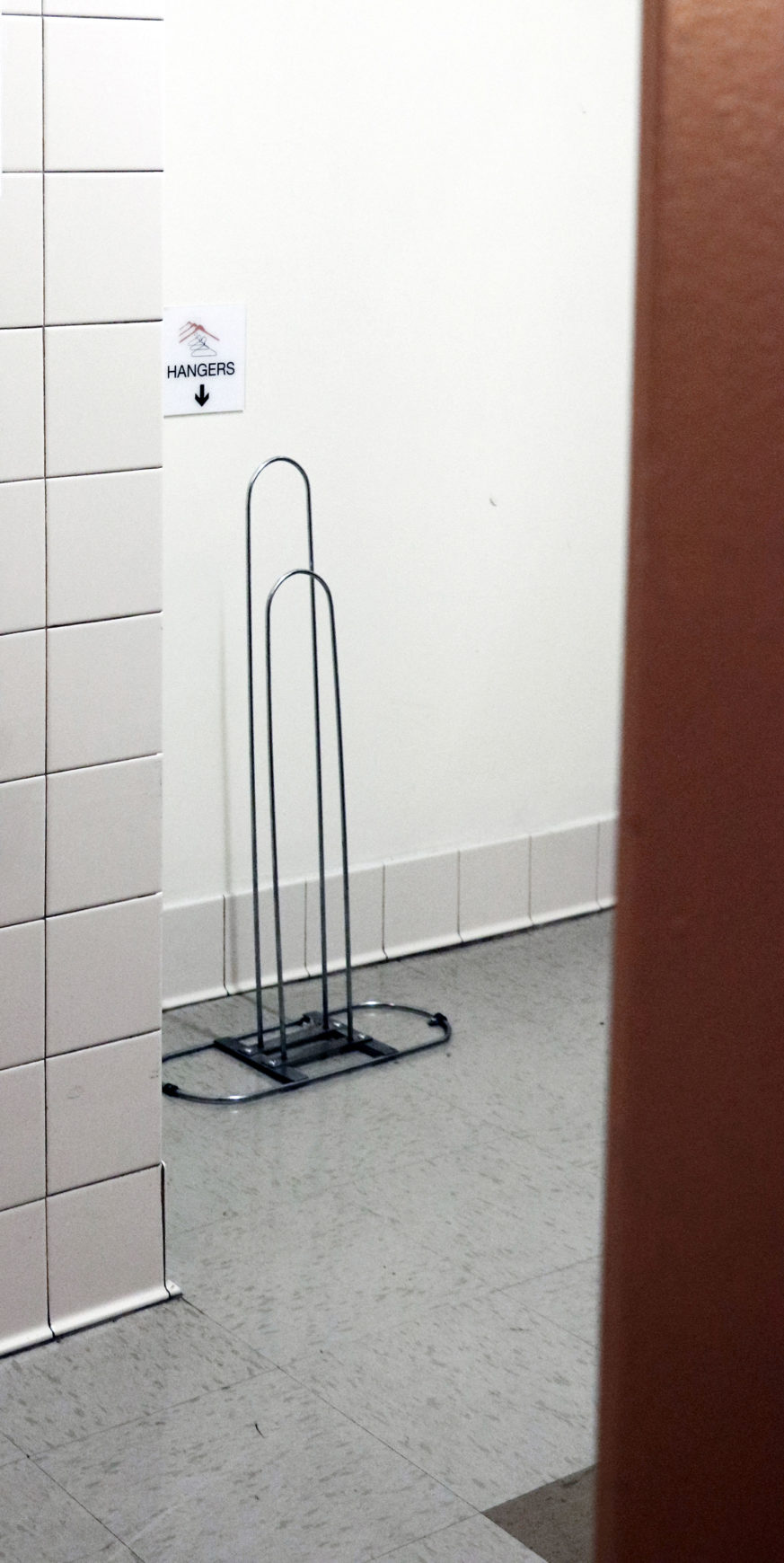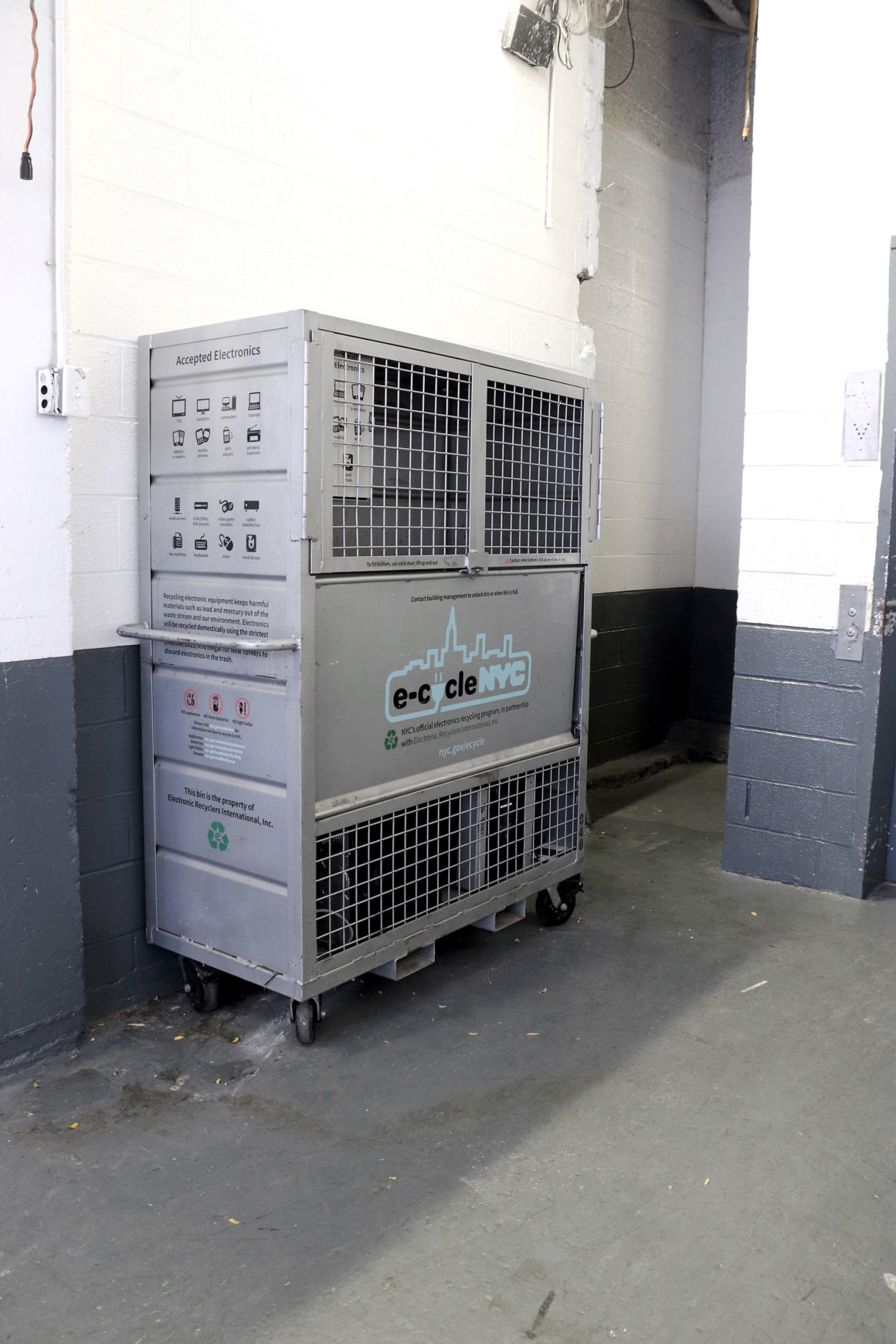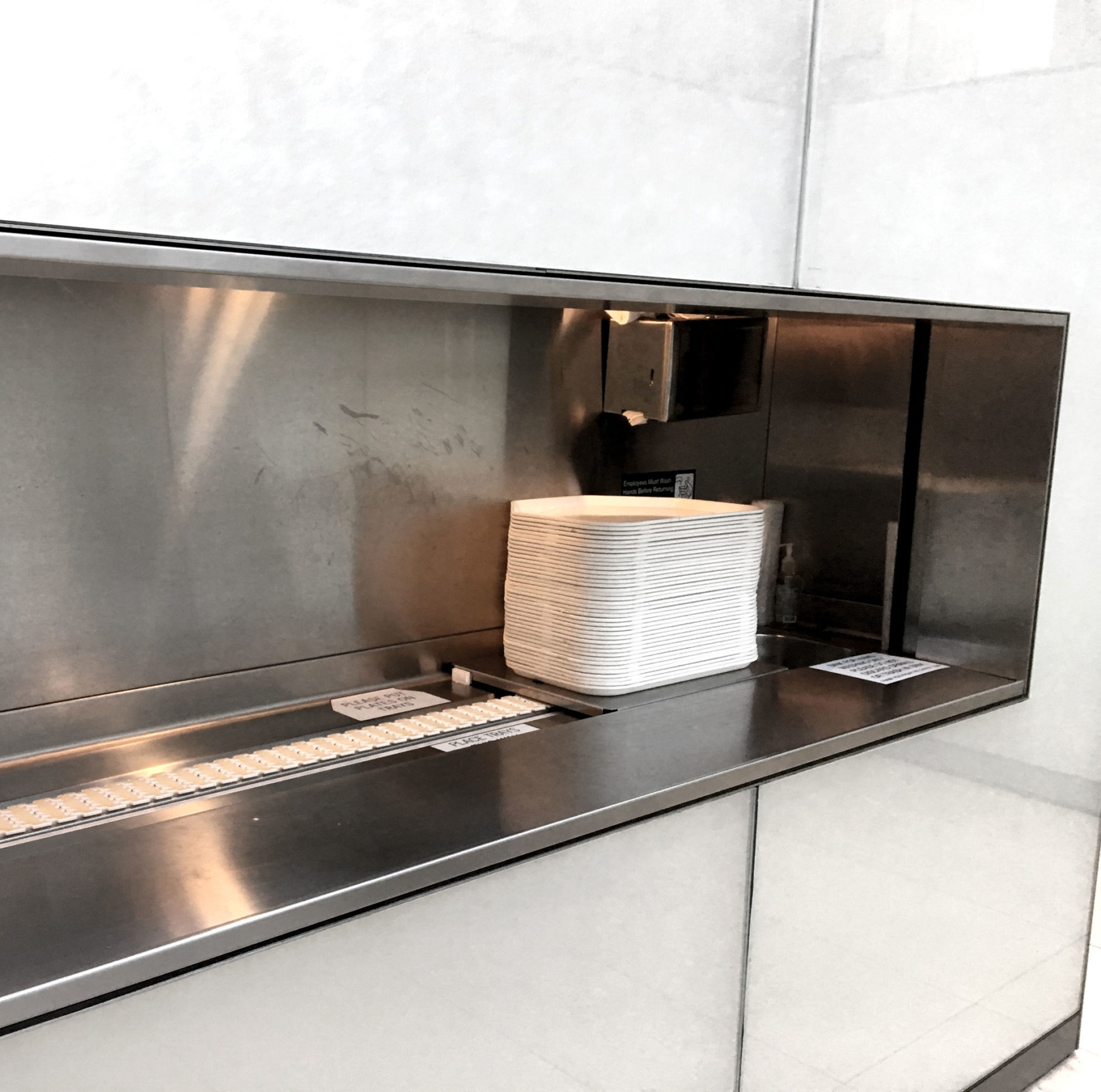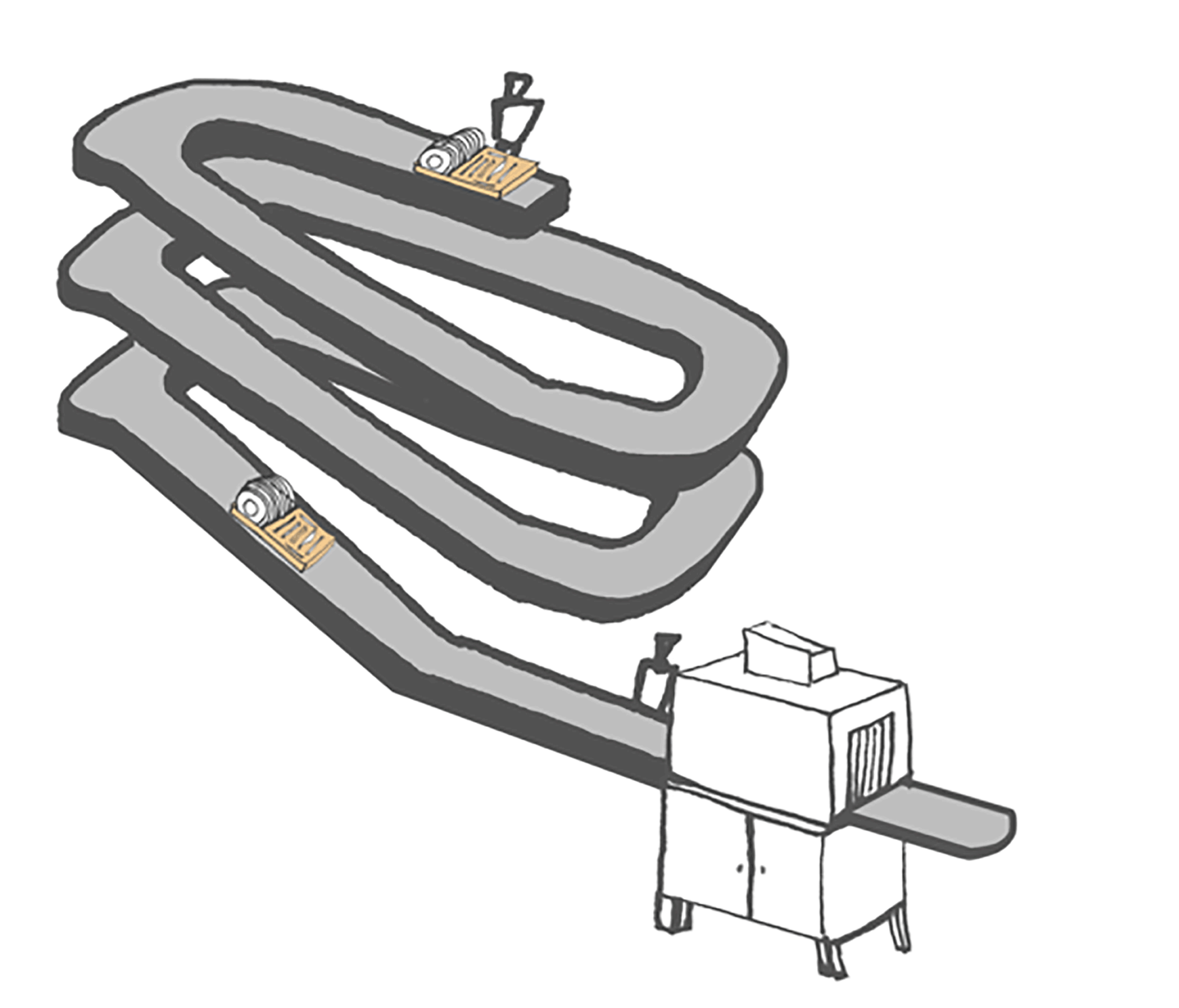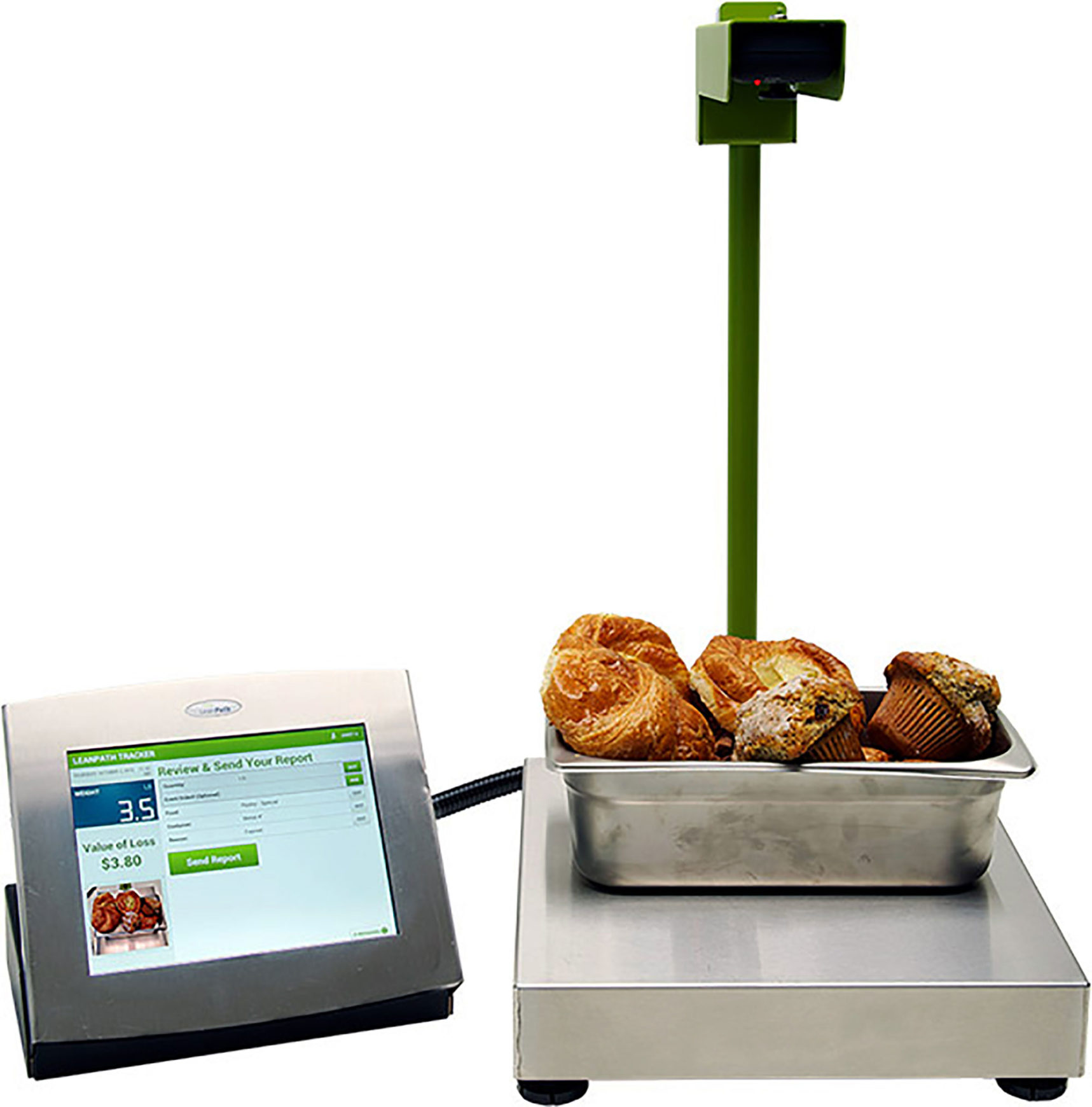Architects often consider how to reduce waste during building construction, but they can also design to reduce ongoing waste generated during the life of their buildings, just as they consider reducing energy and water use. Designing for material flows will not only reduce waste sent to landfill but also improve convenience for residents, working conditions for staff, the quality of public space around the building and the successful operation of the collection and the processing infrastructure into which it feeds. Strategies fall into the following broad categories:
1. Planning for Materials Flow Through a Building
The flow of goods delivered to the building is mirrored by the flow of outbound discarded materials. Planning for these flows is key to efficient waste management. Plans should cover quantities, routes, equipment and staff procedures, storage space design and collection setout.

Moving waste materials through service corridor
2. Making Waste Separation Easier
Good design can simplify the disposal of materials in separate containers and increase diversion rates. Design can also create a coherent system for users via consistent visuals and signage throughout the building and by incorporating waste data feedback. If trash disposal is more convenient than recycling (and organics) streams, separation will be a greater challenge. ← Equal convenience for recycling (not necessarily organics) is the current minimum standard in many cities, including New York. For discussion, see DSNY, “Recycling in Context” (2001), 28, link.

Waste separation station
3. Reducing Material Consumption Through Programming Decisions
Lowering consumption reduces eventual waste generation. Therefore, any programming decisions to reduce the amount of items procured—for example, through sharing equipment and furniture in an office space; or providing reusable rather than disposable dishware in a restaurant—should be encouraged.

Reusable plates at buffet
4. Reducing the Volume of Waste
Equipment that reduces the volume of waste can reduce storage space, setout space and collection truck mileage. Organic waste pretreatment can significantly reduce the weight as well as the volume of organic waste. Equipment adds costs and operational considerations and is only recommended in certain situations. Using the Waste Calculator can help in determining when equipment should be considered.

Baled cardboard reduces setout space
Designing for zero waste is a collaborative process, and it needs to start at the beginning of a project. Considerations per phase include:
Predesign Phases
- Include waste in sustainability planning: Hold integrative design workshops, set goals for waste reduction and diversion, organics separation and reusable dishware usage.
- Programming: Look for opportunities to share space and equipment.
- Use the waste calculator for an initial estimate of waste quantity.
Schematic Design
- Consider typology choices (residential, commercial and truck collection)
- Initial waste management plan: Plan for disposal, separation, storage, movement and collection of all waste streams. Coordinate with building management, engineers, and landscape architect.
- Consider using waste-metering methods.
Design Development and Construction Documents
- Design for any volume reduction equipment.
- Update waste management plan: Include any commercial or institutional tenants.
- Update waste goals: Look into opportunities for waste reduction, donation, packaging, and supplier takeback of packing containers
- Develop waste-metering methods.
- Develop waste/recycling stations and signage.
Handover and Occupancy
These may be developed by a building owner and management but should build on previous waste management plan.
- Final waste management plan including standard operating procedures and all bin types and locations.
- Develop awareness and education programs.
- Re-do waste calculations to reflect any waste reduction and diversion goals.
- Develop waste/recycling stations and signage (if not already extant).
- Consider volume reduction equipment (if not yet done).
For a new building, all the phases should be considered. For an existing building, the starting phase depends on the extent of renovation work. Recycling and better waste management can also be retrofitted into buildings with no ongoing renovation.
The Best Practice Strategies indicates applicability for commercial and residential buildings. For institutional buildings choose based on occupancy.
Planning for Waste as a Material Flow
Designing a building for those who serve the building, as well as those the building serves, makes the building better for everyone. Designers often fail to take into account the processes of maintenance staff and the flow of materials in a building. When these are accounted for, employee safety and satisfaction, hygiene and occupant satisfaction all improve. When they’re not considered, points of friction are introduced to the system, frustratingly workers daily with ever increasing impact.
In visiting many buildings, we have seen great differences between them. Because an architect’s scope of work doesn’t generally allow him/her to find out how well a building performs for the maintenance staff, the architect remains unaware of problems so can’t learn from them. And we’ve noticed that when building management values the creativity and ideas of every player, friction is reduced and solutions are found.

The depth a designer can reach in planning for waste varies depending on whether the building is existing and occupied or is planned without an idea of future occupant. Strategies below are comprehensive and should be considered as far as relevant.
2.01 Determine waste streams and quantities
Planning for waste requires knowledge of the type and quantities of discarded materials. Planned space should be flexible because waste streams and recycling procedures often change over time.
Waste streams and quantities can be determined by:
- A waste audit for an existing building or from another location of the same business. Options can range from in-depth—weighing waste containers or bags—to a full “bin dig,” in which all waste is separated, categorized and weighed. In more-complex commercial buildings, hiring a waste consultant to make accurate estimates is common practice.
- Average waste data for different use categories. In NYC, there are City Environmental Quality Review (CEQR) requirements to include estimated waste data in initial environmental assessments for large developments that could lead to 50 or more tons of discarded materials per week. To assist in calculating waste, the CEQR manual includes estimated pounds per resident, employee, student, hospital bed and inmate for different building uses.
- Waste Calculator: This uses local average waste data and includes recommendations for volume reduction equipment, storage containers and area.

The Zero Waste Design Guidelines Waste Calculator
2.02 Plan a Route
Designing a route through a building for material discards requires consideration of transport methods, staffing and any restrictions in usage of elevators, service corridors or chutes or lifts. Strategies include:
- Minimize travel distances for staff.
- Minimize handling/transfer points as there is potential for contamination of streams at each handling.
- Provide for safe vertical transfer methods via elevator, lift, ramp or chutes. Stairs are common in older low-rise commercial buildings, but limit the weight of waste containers, and can lead to staff injuries. Service elevators take up additional area, but use of passenger elevators can inconvenience occupants. Material lifts (dumbwaiters) cost less, but staff do not enter, so need to coordinate loading and unloading. Though ramps consume space, they can be designed into exterior courts or yards, so service doors can come from cellar spaces.
- Consider transfer methods: Is an elevation change required, such as that at a loading dock that enables tilt trucks to tip waste into a 35 cu yd container? Otherwise, it may be necessary for staff to lift and throw heavy bags, or provide a mechanical means of lifting.
- Consider time restrictions for elevator usage, movement through common spaces, staff hours or collection hours and the like.
- A semicircular ramp is designed into the exterior court, allowing waste to be wheeled from the basement to the sidewalk
- Top to bottom: Multiple chutes to wheeled bins; Multiple chutes to 2 cu yd containers
Consider containers for transport and storage
Waste is usually discarded and transported in containers. Different sizes and configurations suit different purposes. (See Waste Bins in Buildings, below.) Consider:
- Whether provision and space needs to be given for washing containers
- Clearances and turning radii for containers
- Storage of transport containers
- Staff safety (weight of transport containers)

Consider chutes and sorters
Chutes, which rely on gravity to transport waste through a building, are more common in residential buildings. The Chute Options infographic below shows the most common options and considerations.

When chutes connect to bags in wheeled bins, they have to be serviced much more frequently. If they can connect, through a compactor, to larger 1–2 cu yd containers, the connection can be tighter, improving hygiene and requiring less frequent servicing. (See Avalon case study.) This is especially important for organics chutes. There are very few buildings that have organics in chutes. Issues include a requirement for more frequent washdown, and concerns about compostable bags breaking over a certain number of stories. Recycling chutes may empty into tilt trucks, then transfer the material to bags for setout.
Chutes often get blocked when residents insert bags of textiles or cardboard. Separating textile and cardboard collection can help in reducing the likelihood.
2.03 Design storage space
Research shows that well-designed storage spaces increase diversion. Because many commercial buildings lack adequate storage for waste, it ends up monopolizing loading docks and corridors, pushing loading to the street and/or blocking egress. Consider: ← DSNY research—2005 WCS multiunit study.
- Storage area required and clearances for movement of containers
- Mechanical considerations: ventilation, temperature, lighting, water and drain for washing down containers
- Access to exterior
- Flood plain: With a cellar at risk of flooding, consider using larger containers as opposed to bags, or store waste at grade.

Loading dock filled with waste storage
2.04 Plan for collection
See the Collection & Urban Design chapter for recommendations on collection typology.
There are many competing uses for NYC sidewalks, including bike racks, street furniture, curb cuts, and tree pits, which may be elongated or include bioswales for additional stormwater infiltration. Designers of new buildings often fail to coordinate these uses with storage space for waste before it’s set out for collection. When the quantity of waste that will be set out is known, a designer can often plan a sidewalk to accommodate it, whether the waste is in bags or containers. However, with tall buildings or those creating a lot of waste, there may not be enough sidewalk space to accommodate it, and setting out waste in bags at the curb can block pedestrian traffic. In such a case, the design could allow staff to roll out 1–2 cu yd rear-load containers at collection time (for private hauler pickup), or 20–40 cu yd compactor containers could be placed in a loading dock or exterior space, and buildings could share them (see Battery Park City case study).

Elongated tree pit for stormwater infiltration leaves no space for waste setout
For existing buildings, a lack of interior space for waste storage has led to permanent storage of waste containers along street fronts—in bins, enclosures, and cages—or behind fences, which often detract from the pedestrian sidewalk experience. (See NYC Rules for Setout infographic.) Another solution that would require changes in city policy is shared collection within the public realm. For shared collection possibilities, see Best Practice Strategies in Chapter 3.
- Ad-hoc residential storage enclosures along street fronts
Considerations for collection design:
- Types of containers or bags used
- Timing of collection, and whether interim staging is required
- For wheeled containers: staffing considerations around moving containers back into the building and washing (Note: DSNY does not currently pick up 1–8 cu yd containers from buildings not already receiving the service.)
- Access to collection area
- Coordination with planting zones, street furniture, and sidewalk design
- Coordination with loading zones and curb cuts
- Enclosures and screening if permanent sidewalk storage is provided
- If the building has both private and DSNY collection, plan separate setout areas to reduce confusion for haulers and delineate responsibility.
2.05 Consider staff procedures
Designers need to consider staffing and maintenance requirements, and it is helpful if they can be involved in developing Standard Operating Procedures (SOPs) which can be reinforced by building management post occupancy.
- Consider staffing requirements and the balance between labor time and first costs. Note first costs can be reduced and maintenance included by leasing waste management equipment rather than purchasing it.
- Collaborate with building management to develop SOPs with clear steps for moving waste streams through the building. Provide information so building management can follow up with education, training and support to increase staff motivation and accountability.
- Signage and visual cues should be consistent throughout the building.
- For existing buildings, draw on the staff’s insight and creativity and collaborate on analyzing the system and devising operating procedures.
- DSNY offers training for building management.
- For building staff within 32BJ union, training is offered.

Staff transferring waste from transport bin to compactor container
2.06 Plan for takeback of delivery materials
With the rise in internet commerce, buildings—especially residential ones—are subject to a greatly increased flow of incoming and outgoing materials. Design of entrances should take package deliveries and outgoing packaging into account.
Explore plan layouts to reduce packaging and delivery waste; consider designing loading docks and package rooms to accommodate takeback of crates and packaging. ← Businesses are starting to use more reusable packaging. See Reusable Packaging Association, link.
- Provide storage in food service spaces so that suppliers can take back delivery packaging such as crates, wooden pallets and reusable bottles with the next delivery. (See Park Slope Food Coop case study.)
- Provide storage in package rooms for return of insulated cool packs and bags used for grocery and meal kit deliveries. Consider providing a refrigerator if local delivery services will deliver without insulation.

Delivery crates and containers stacked for takeback
2.07 Considerations for multi-tenant buildings
It is not unusual for every tenant in a multi-tenant building, especially manufacturing buildings, to have their own waste hauler. This automatically increases the number of truck trips to the building, producing inherent excess costs and impacts for building occupants and the public. It also limits the ability to use shared equipment in shared building or exterior space. And it increases the complexity
of building-wide waste-management operations, since there may not be uniformity with regard to separation requirements, signage, and transparent pricing. Shared equipment can dramatically lower costs and improve waste management—reducing volume and increasing diversion. Employing a staff member to oversee shared equipment can pay for itself. There are various means to charge individual tenants for usage. (See BPS 2.20 and theMART case study.)
- Consider building-wide collection arrangements with a single carter.
- Consider providing shared storage and equipment in multi-tenant buildings. Charge tenants for use rather than a flat fee.
- Ensure that lease language requires individual tenants to use shared storage and equipment, or to provide space for waste storage when shared space is not provided or accessible at all hours.
- Ensure that lease language requires tenants to adhere to waste management rules.
- For residential and commercial buildings with separate collection, separate systems will need to be designed.
Waste Diversion Strategies
Waste diversion is a measure of the proportion of materials that can be diverted from the refuse stream. The degree to which materials are effectively captured at the point of disposal is affected by the relative convenience of disposal and design that makes the user aware of the system to be followed. Education and informational feedback can reinforce this.
2.08 Provide equal convenience disposal (residential)
Research has shown that leveling the playing field for all daily waste streams increases diversion. If residents have convenient access to a trash chute but must take recycling and organics to the cellar, they are more likely to throw all waste streams down the chute. ← The digital key may calculate times the chute is used rather than exact volume.
Where the waste generated will be predominantly one stream—for example, paper and cardboard in a mailroom—then it may make sense to provide only bins for those streams, possibly alongside a general trash bin for incidental waste.
Apartments
Design receptacles for all waste streams together within the apartment.
- Solutions include cabinetry with pullout bins for multiple streams and/or countertop organics caddies. If nothing is designed and built in, the outcome is often a large trash can and inconvenient recycling storage.
- Eliminate general-purpose waste receptacles in other rooms, where all streams will be mixed, or provide divided or stacked bins for multiple streams.

Kitchen pullout drawers for multiple waste streams
Multifamily residential
The building code is written for equal convenience disposal of trash, MPG and paper recycling streams, but not for organic waste. Many existing buildings do not co-locate recycling and trash, and the ease of co-locating organics bins varies with typology. (See Residential Typologies.) Cities with extensive organics programs, such as San Francisco and Milan, have closed chutes and recommend discarding all waste streams at the ground floor, but NYC building code does not always allow for this. Further research is needed to determine the best strategy for building typologies without easy accommodation of organics collection alongside other streams—co-location of bins may not be the best solutions for maximum diversion in some existing buildings. Design for co-location of organics and all waste streams in waste rooms:
- Coordinate with building management to determine if staffing levels allow for minimum daily servicing of organic bins placed in trash rooms. Other strategies to minimize odors include exhaust ventilation and cooling.
- If an organic chute is provided, the receptacle at the receiving end needs to be closely connected to the base of the chute—so a 2 cu yd container is more suitable than a wheeled bin. Organics chutes are not common, but organic material comes down mixed trash chutes and regular chute maintenance is designed for organic waste sticking to the sides of the chute (with washdown and enzyme treatments). There are concerns that compostable bags are more prone to breakage than regular plastic bags, and piloting of organics chutes is important to address such issues. (See Grand Millenium case study.)
- Existing single chutes can be retrofitted with a sorter system, allowing equal convenience disposal of multiple waste streams.

Equal convenience disposal in waste room at The New School dormitory
2.09 Provide equal convenience disposal (Commercial)
Research has shown that leveling the playing field for all daily waste streams increases diversion. When the waste generated will be largely one stream—for example, organic waste in a kitchen, or paper and cardboard in a mailroom—it may make sense to provide bins for that stream alone, possibly with a general trash bin alongside for incidental waste. Disposal options for all streams need to be provided within the facility.
Offices
Create central waste stations.
- Provide bins for all waste streams in a central area, such as a pantry. Eliminate trash bins at desks, or provide only paper-recycling bins and small desk bins for tissue and wrapper–type trash.
- Ensure that when staff takes waste to a storage location, there are separate bins for each waste stream.

Desk bin for paper recycling, with small trash receptacle
Restaurant recycling stations
Waste and recycling stations in restaurants are often badly designed and confusing for customers, leading to highly contaminated streams and low diversion rates.
Design recycling stations to accommodate all streams generated within the facility. Streams to consider include:
- Organic waste and compostables
- Recycling: metal, plastic and glass
- Liquids: so customers can empty bottles prior to recycling to reduce weight and make handling easier
- Trash
Typically, customers are discarding only materials bought at the facility, so if streams are not created, separation can be simplified—even down to just organic waste and liquids. (See BPS 2.10.)

Recycling station with clear visual cues
Restaurant kitchens
The most common stream in kitchens is food waste, but consideration needs to be given to plastic wrapping and cardboard, and collection of paper, metal and glass needs to be provided in the facility per NYC law. Containers for waste cooking oil should also be provided for and they are typically serviced along with the grease trap. Provide for all food waste generated at all food preparation areas:
- Provide bins for the waste streams generated at each location (this may mean that only organics bins are required in the kitchen, depending on procedures).
- Place organics convenient to sites where food waste is generated, such as food preparation stations and dish areas in restaurants.
Waste storage locations and loading docks
Provide bins of appropriate size at each location where waste is handled:
- Each handling/storage/collection point for waste needs to have appropriate bins for every stream so separated waste does not get mixed up at a later point.
- Bins should be sized for the expected volume of each waste stream—for example, although more recyclable waste than trash is usually generated, a common scenario is to provide a small recycling bin alongside a large trash bin. This leads to lower diversion levels.
- Floor plans that map out bin locations help operational staff place bins in the proper locations each day.
2.10 Provide clear visual cues and signage
The average person spends a few seconds deciding in which bin to dispose of their waste. With good design, this information can be conveyed quickly via visual cues. Reading requires more time and, in multilingual settings, requires translation. Research has shown that visual cues and signage greatly reduce contamination and increase capture rates. ← Sean Duffy et al., “It Matters a Hole Lot: Perceptual Affordances of Waste Containers Influence Recycling Compliance,” in Environment and Behavior 41, (2008): 747, 10.1177/0013916508323737.
Use standard signage.
- Use signs and bin labels with clear images (sketches or photos) and internationally accepted color-coding for each stream: blue for mixed recycling, light blue for paper, green for organics and black for trash. Recycle Across America is one example of standardized signs. Standardizing signage allows easy recognition for the public and employees.
- Make sure signs are consistent throughout a building. In multi-tenant buildings, encourage tenants to use standard signage provided by the building.
- Signs should use similar verbiage to DSNY materials. For commercial buildings, we suggest using international standard colors for paper (light blue) and organics (green), which differ from DSNY colors for residential collection (green for paper and orange for organics). We do this to encourage national or global commercial businesses to standardize across all sites.
- For buildings with DSNY pickup, use the free signage—available in many languages—provided by request from the DSNY website.

Clear visual cues and signage for 4 recycling streams (trash is on the left behind a partition, with a small opening)

Monthly diversion rate displayed prominently at waste station
Design openings to cue user of suitable contents.
Shaped openings can cue users to the appropriate stream and stop entry of other streams. For example, a small circular opening accepts only bottles and cans for recycling, and a linear opening can signify the place for paper. Be aware that openings need to be large enough to accommodate all materials in each stream. For example, smaller holes for bottles and cans will often not accommodate plastic takeout containers or slip openings for paper may be too narrow for a book, frustrating users and leading to poorer diversion.
Use color to indicate waste stream.
- Use standard colors for each waste stream, either DSNY’s for NYC (orange for organic waste, green for paper) or international (green for organic waste, light blue for paper).
- Color can be used for the lip of an opening in a waste station, or the color of a bin or lid, as well as for the signage.

Different color bins with clear signage and a lid that needs to be lifted for trash
2.11 Provide opportunities for feedback
Visual feedback has been shown to change behavior, from research with visible energy meters and dashboards. ← See Sander Hermsen et al., “Using feedback through digital technology to disrupt and change habitual behavior: A critical review of current literature,” in Computers in Human Behavior 57 (4/2016), link.
Display waste data to change behavior.
Consider displaying waste generation and diversion information at the point of waste generation to change behavior. (See Etsy case study.)
Virtual feedback
Give feedback virtually, through building-wide digital platforms.
2.12 Develop awareness and education programs
Building occupants who generate waste must be made aware of the system protocol. Combining signage, visual cues and feedback with awareness and education programs can ensure that all waste generators understand the process. Add regular communications to report feedback.
- Consider starting a resident engagement program. (See Toronto case study.) ← “Multifamily Recycling: Case Studies on Innovative Practices from Around the World,” prepared by Cascadia Consulting Group for Waste Management Snohomish County Solid Waste, King County Solid Waste (11/2012), link; and Aliza McHugue, “Ensuring Sustainability: The Best Practices in Ambassador Style Programs,” in Global Green blog (8/7/2017), link.
- For commercial buildings, ensure that new staff is trained and regular staff updates are held. For multi-tenant buildings, ensure that leases require staff training.
- Ensure that leases for residential and commercial buildings include requirements for recycling. (Note that DSNY has standard lease language available for residential.)
2.13 Design for occupancy (residential)
Tailoring wastebins to the streams generated is good design that can improve waste handling. Collecting cardboard, textiles and hangers separately in buildings with chutes can reduce chute blockages.
- Provide textile bins in central locations or in the laundry room. Provide bins for ewaste and arrange for separate collection. Apartment buildings can enroll in DSNY’s refashionNYC and ecycleNYC programs.
- In high-end residential buildings, where residents frequently
use dry cleaning services, consider providing a rod or stand for return of hangers. This can also help reduce chute blockages. - In buildings likely to receive many deliveries, consider adding space for cardboard and a means to break it down. (See StuyTown case study.)
- Providing collection containers for waste items outside DSNY’s domain—such as batteries, bulbs, thermometers and syringes—conveniences residents, protects staff and ensures safe diversion of the materials. Building management does become responsible for the waste, so determine the types of hazardous waste to include.15 Some residential buildings also collect used cooking grease, Brita filters, plastic film and pouches, and other items. ← EPA regulates hazardous waste under the Resource Conservation and Recovery Act. For regulations, see US EPA’s “Hazardous Waste Generators,” link.
- Place waste bins for common streams at appropriate locations, such as paper and cardboard collection in mail- and package rooms and textile and plastics recycling in laundry rooms.

- Designing for residential occupancies: refashionNYC textile bin in laundry; ecycle cart; rack for hangers
2.14 Design for occupancy (commercial)
The waste streams of commercial and institutional buildings vary greatly with occupancy. Separating and providing collection opportunities for the streams generated can improve waste diversion. (See BPS 2.09.)
- For restaurants, consider storage for used cooking oil, which can normally be collected by the same hauler that cleans grease traps.
- For food and industrial waste streams, explore the possibility of beneficial reuse for a particular portion of waste stream. There are many examples of food waste generated by one business being repurposed by others. See ReFED website for innovators that use surplus bread to make beer, and others that use spent grains from beer to make granola bars.
- Consider if materials can be removed from the waste stream, or waste can be reduced through procurement decisions.
- Perform a waste audit to understand where discard streams are coming from, and consider whether these can be prevented from entering the building. Etsy did a waste audit and saw a lot of packaging waste came from takeout lunches and beverages. It now provides reusable cups for staff to bring to local cafés (See Etsy case study.)

Fat and bones from meat packers is separated and used to make soap, industrial cleaners, chemical lubricants and pet food

Toast ale is made from surplus bread
Waste Reduction Strategies
2.15 Provide shared equipment and services
In the circular economy, sharing is key, and it can be promoted through building programming. (See BPS 2.26.)
Consider providing shared equipment.
Multifamily residences often offer equipment within shared spaces, such as weights in a gym, toys in a playroom and barbecue grills on a roof terrace. Consider further amenities, such as a shared goods library, which reduces the need for a vacuum cleaner, drill and air bed in every closet.
Design for service, to reduce the amount and frequency of items purchased.
Provide maintenance services such as cleaning, laundry and repairs within the building so there are fewer—but higher quality and more efficient—appliances.
2.16 Reduce materials consumption
Packaging composes a substantial percentage of waste, and food packaging accounts for about two-thirds of the total volume of packaging waste. Washing reusable containers leaves a much smaller environmental footprint than using disposable packaging does (see City of Portland study.) When reusable containers aren’t an option, choosing compostable materials can reduce the volume of waste and its environmental footprint. Paper accounts for 37% of NYC’s commercial waste. ← DSNY, “New York City Commercial Solid Waste Study and Analysis, Summary Report,” 2012, 39, link.
Design to reduce the use of packaging and disposable tableware.
- Program restaurants and cafeterias with dishwashing facilities and use reusable dishware and fountain drinks rather than bottled drinks and disposable plates and utensils. Dishwashing rooms can be remotely located and dishes conveyed by dish conveyors which can even take dishes down multiple stories to less valuable below grade areas. Dish conveyors also put separation of waste in the hands of staff which simplifies separation for customers and reduces contamination.
- Provide reusable to-go containers which customers can take with them and then return to the restaurant or drop in designated bins. (See Columbia University case study.) Provide space for a bin for returns of containers and dishwashers if washed on-site, or access for a third party to pick up and wash off-site.
- Provide water fountains and bottle fillers, drinks on tap and bulk snacks rather than vending machines or packaged goods.

- This dish carousel transports dishes, via a conveyer belt, from the second floor restaurant down to a dishwasher in the cellar.
Provide compostable dishware and utensils.
Coordination with the waste hauler is required to ensure that the final destination facility for organics accepts compostables. Anaerobic digestion facilities do not generally take any compostables (these are filtered out with other contamination and disposed), and some compost facilities will not take compostable bioplastics. If compostables are a high proportion of overall organic waste larger wheeled bins can be used for in-building transport and collections (64–96 gal.) because compostables are lightweight. Organic pretreatment equipment generally will not accept compostables. (See BPS 2.24.)
Provide compostable dishware, cups and utensils (paper compostables are environmentally preferable to bioplastics). In a food service environment, such dishware, cups and utensils can greatly simplify waste collection as all discarded items may fall into one waste stream: organic waste. If a large generator is using compostables, a compactor would be recommended for volume reduction.

Reusable ‘Go Boxes’ are used in Portland, Oregon
Design to reduce the use of paper.
- Design for digital information with digital displays and smartboards rather than for usage with easels, printers, copiers and file cabinets.
- Provide energy-efficient hand dryers rather than paper towels. Studies have shown that these dryers, especially the high-efficiency ones, have a lower environmental impact.
2.17 Reduce food waste generation
Food waste is a big issue in the US, with 30%–40% of all food being wasted, mostly in consumer-facing businesses such as restaurants and grocery stores and homes. When food is wasted, all the energy, water and labor involved in farming, harvesting, processing, packaging, cooling and transporting the food is wasted as well.

Design food storage design to reduce waste.
Design kitchens to minimize spoilage by avoiding food loss with visible storage, shallow refrigerators and refrigerated drawers.
Design food display to reduce waste.
- Design buffets for minimal waste (smaller buffet pans or rounds) versus traditional large “hotel pans.” Buffets in typical food service environments can be major sources of waste, especially if self-service; once consumers have scooped from a dish, the food safety chain is broken and leftovers can’t be reused or donated.
- Reduce serving waste in restaurants by using smaller plates and trayless dining to lessen overconsumption and leftovers by diners.
- Design displays for food in grocery stores so the oldest food is purchased first and size displays so there is a quick turnover of displayed food.

Buffet with small buffet pans and reusable dishware
Design for equipment to track food waste to change purchasing decisions.
- Provide food waste tracking systems in food businesses. Food waste tracking and analytics can reduce food waste in consumer-facing businesses by up to 35%. A scale with an input screen to track food waste is placed adjacent to the organics bin. Software analyzes the data and gives insights and strategies for waste reduction. Digital systems include LeanPath, Winnow and Phood; manual tracking systems can also be used. ← “New prevention technologies are emerging, including waste-tracking tools and packaging innovations. Interviews with ReFED Advisory Council members indicated that these technologies have reduced waste by 5% to 35% in initial pilots,” ReFED, “Roadmap to Reduce US Foodwaste by 20%,” 2016, 29, link; For example of large-scale pilot see: “WWF, AHLA, Rockefeller Foundation Band Together to Tackle Hotel Food Waste: The three groups aim to develop a toolkit that will help hotels prevent food waste from being generated,” Waste 360, 3/22/2017, link.
- The technology is still new, but refrigerators are being developed for residences that can help owners track food using camera technology to minimize waste.
- Reducing food waste generation through weighing waste manually or use of a digital software (Lean Path shown)
2.18 Facilitate donation and reuse
After reducing consumption to match need, reuse of items is the next strategy down on the waste hierarchy. Building design can facilitate reuse of unwanted items, and this is often done informally—the front stoops in brownstone neighborhoods make perfect display shelves for selling or giving away unwanted goods. In larger buildings, cellar space is sometimes used to allow reuse of larger discarded items by others in a building. However, as space is normally at a premium, it may be more convenient to share available items digitally, through resident portal systems such as BuildingLink or ActiveBuilding. When inadequate space is provided for bulk items awaiting collection, crushing equipment may be used instead, destroying the items and preventing reuse. Food donation, mentioned above, requires special consideration.
Design for storage for bulk items.
Provide a physical space or online platform to allow reuse of items by others within a building and enough storage space for items awaiting pickup by a reuse business or charity.
Design for access to and refrigeration of food donations.
- Enable donation of perishable food by providing refrigerated and dry storage in a convenient spot, especially if pickup needs to happen after hours. For more information on setting up a food donations program, consult the NYC Department of Health and Mental Hygiene’s Guide for Food Donors.
- Work with donation-matching companies that help find local partners for restaurant food waste. ← e.g., Food Donation Connection helps food service companies develop and implement food harvest programs, link.
- Consider donating refrigerators in residential buildings so residents can share food that might otherwise go uneaten.

Brooklyn stoop sale
2.19 Design to incorporate financial incentives such as SAYT (residential)
Metering and charging for water usage and electricity usage has been shown many times to significantly reduce water and electricity use, and it makes sense that the same is true for waste. Pay-as-you-throw schemes have been shown to reduce waste and increase recycling in other cities, and DSNY is currently studying implementation of a save-as-you-throw (SAYT) initiative within NYC. If the financial benefits are only applied at a building level and not directly related to the amount of trash an individual household produces, the personal incentive will be missing. Even if SAYT is not implemented, buildings can be designed to reduce waste and increase diversion through financial incentives.
Design so financial incentives can be applied at household level.
- Consider strategies that track waste generation to individual households. Strategies include requiring an ID tag to open a chute, with incentives for reduced usage especially of a trash chute. If a SAYT system involves purchasing special bags, then it may be necessary to set up cameras or publically visible access sites to discourage the use of unauthorized bags.
- Other less accurate but simpler means to charge for waste generation per user could include financial incentives linked to the frequency a resident enters a waste room, through data connected to the resident’s digital key.
2.20 Design to incorporate transparent pricing by stream (Commercial)
Design commercial buildings to track individual business waste, and provide feedback.
- In multi-tenant commercial buildings, consider systems that weigh and track waste with scales at loading docks with combined compactors and containers. (See theMART case study.)
- In commercial buildings consider having maintenance staff use hampers with integrated scales and input screens to track waste, using free software such as Divertsy by Etsy. (See Etsy case study.)
Volume Reduction Strategies
Equipment that reduces the volume of waste streams can reduce the area required to store and set out waste, labor costs and will reduce the number of trucks needed to collect the waste, reducing environmental impacts. It can also make the job of handling waste more efficient and less dangerous. Because organic waste is up to 90% water, it is heavy to move and expensive to cart away, but there are opportunities for substantial volume and weight reduction. On-site waste pretreatment is typically used in commercial buildings only. (See BPS 2.24.)

Waste is weighed at central storage area
Careful consideration should be given to the factors below before equipment is specified, as it is not suitable for every situation.
Equipment types
- Compactors (trash, cardboard, metal, plastic and glass recycling, organics)
- Balers (cardboard, metal and plastic, including film)
- Crushers, shredders and grinders (glass, paper, plastic)
- Organic waste treatment (organic waste, typically food waste)
Considerations include:
- Cost and maintenance
- Waste stream suitability
- Compaction ratio
- Labor and training required
- Size and clearances
- Power requirements and energy usage
- Size and collection method for waste output
- Digital capabilities, for automatic service and data on amount of waste generated.
- For multi-tenant buildings, whether equipment is centralized or within individual tenant space.

Cardboard and recyclables spilled out into exterior areas before a baler was installed in the waste room

Cardboard and recyclables spilled out into exterior areas before a baler was installed in the waste room
2.21 Volume reduction equipment: residential compactors and balers
Compactors
Compaction ratios for compactors are typically 3:1 or 4:1 for trash, and 3:1 for cardboard and recycling. ← Compaction ratios are from Great Forest.
Chute-fed compactors
Compactors are required for trash for larger residential buildings (See Building Code.) Typically the waste chute feeds directly into the compactor which packs trash into a long tube of plastic. Staff tie off the bag at regular intervals, and cut them into “sausage” bags. (See Chute Options.) Chute-fed compactors can also pack into front- or rear-load containers—typically 2 cu yd—which reduces labor significantly. There are additional considerations for containers (see Truck Collection Typology 3). Currently, DSNY only collects front-load containers from grandfathered buildings already receiving container service.
Stationary compactors
DSNY has roll-on/roll-off (RoRo) container specifications for 35 cu yd container compactors, which can be used for trash or paper and cardboard. DSNY recommends a trash compactor container in buildings with more than 500 apartment units.
The compactor is typically ground mounted with a separate mechanical unit. It automatically lifts 1–2 cu yd containers or tilt trucks and empties them into the compactor. The maximum size of the compactor is 35 cu yd, and it is picked up by a roll-off truck when full and returned empty.

Stationary compactor with hopper feed (collected by DSNY)
Balers
(See BPS 2.22.) Cardboard and metal and plastics can be baled. For DSNY pickup, bales need to weigh under 60 lb. Compaction rates vary but can be up to 8:1 for cardboard and 5:1 for plastic and metal recycling.

Balers can make small bales under 60lbs for DSNY pickup

2.22 Volume reduction equipment: commercial compactors, balers, crushers and grinders
Compactors
Self-contained compactors
The most common compactors used in NYC commercial buildings are 30 or 35 cu yd self-contained compactors, though options range from 10–40 cu yd. These can be used for wet or dry waste. The compactor is part of a self-contained unit that is taken away by roll-off truck when full and brought back empty. They are typically located on a loading dock with a raised platform, allowing waste to be tipped into the compactor. If there is no dock platform, compactors are normally side loading or have cart tippers. The compactors can also be fed through a chute—for instance, when the compactor is outside and the feeding point is inside. Compactors can be split into two sections to compact two waste streams: say, trash and recycling. They can also be customized for the size constraints of a loading dock.

Self-contained compactor in loading dock
Compactor containers can be shared between tenants in a multi-tenant building and accessed with an electronic tag when waste is weighed prior to putting in the compactor, enabling cost to match weight of waste generated. Sensors can also automatically notify the service company to come and collect the full compactor. Considerations for interior compactors include:
- Headroom: Space and clearance for servicing and truck access for removal
- Method of filling: Provision of a height difference, for example from a loading dock platform, allows material to be tipped into the compactor from a tilt truck, avoiding the need for manual lifting of bags or a cart tipper.
- Weight requirements
- Staffing: must meet ANSI and OSHA best safety practices
Stationary or breakaway compactors
These are commonly used for cardboard and other dry good compaction. The compactor is ground mounted and feeds compressed material into a large 10–40 cu yd container that is picked up by a roll-off truck when full.
Breakaway compactors are also serviced by DSNY, which has its own RoRo container specifications. These allow containers up to 35 cu yd and stipulate clearances.
Hand-fed compactors
Stand-alone compactors can be fed by staff (putting in bags) and packed into integrated wheeled-ins or 1-2 cu yd containers. Vertical compactors which pack into 3–8 cu yd containers are common for wet waste applications where there is not space for larger compactor containers.
Compacting receptacles
Compacting waste receptacles, which can be used for trash or recycling, can be interior or exterior and are safe for public use. A typical installation in NYC is the exterior Big Belly street receptacles. They are digitally enabled to alert maintenance staff when they require emptying.
Balers
Commonly used for cardboard, balers can also be used for metal and plastic recycling (cans and bottles) and plastic film, although each stream should be baled separately to retain the commodity’s value. Consideration for an on-site baler includes space and clearance for servicing the machine and space for the bale to be off-loaded, stored and moved to the setout location. This is commonly done with a hand trolley, though can be with a forklift and pallet. Breaking down cardboard and putting into a baler is more labor intensive than putting into a large compactor but less labor intensive than hand bundling.Compaction rates vary but can be up to 8:1 for cardboard and 5:1 for plastic and metal recycling.
Crushers and Shredders
See also food waste pulpers and shredders under Organic Waste Pretreatment, below.
Glass crushers
These machines are useful for volume reduction for businesses that generate a high volume of glass bottles not returnable for reuse; the compaction ratio is approximately 5:1.
Paper shredders
Used for security purposes, in disposing of sensitive documents, shredders typically remove a large proportion of paper waste from haulers’ waste stream as they are serviced by a separate company. Storage must be provided for shredding consoles (locked bins for paper).
2.23 Organic waste pretreatment (residential)
In residential buildings, options are usually a form of composting or in-sink food waste grinders. While the latter reduce vehicle miles traveled, they can also overtax wastewater treatment plants (WWTP), and whether there is beneficial use of the biosolids depends on the WWTP. ← We referred to data from Foodprint Group and Nora Goldstein and Charlotte Dreizen, “On-Site Food Waste Pretreatment: Guide to equipment and systems for businesses, institutions and venues that manage food waste on-site,” in BioCycle 58 (2017), link.
In-sink Food Waste Grinders
- Food waste is mechanically broken down and disposed of through the sewer.
- The purpose is to avoid hauling impacts. Food waste grinders discharge effluent with high levels of total suspended solids (TSS) and biological oxygen demand (BOD). In-sink grinders are not permitted in NYC commercial facilities, although they are in residential buildings. NYC DEP is monitoring their impact on WWTP so rules may change in the future.
- Equipment is very compact and fits under the sink. Organics are washed directly into the sink, maximizing convenience.
- Can process all food waste but vendors suggest that coffee and eggshells can be bad for building plumbing. Non-food items should be kept out of disposals.
- Water and electricity usage is moderate, and water usage varies depending on moisture content of waste.
- Environmental impacts are mixed. In-sink equipment cannot process soiled paper and other material that would otherwise be composted limiting potential for diversion. The pretreatment phase of sewage in a WWTP is expensive and having additional solids go through it adds costs and can overtax the WWTP. Whether there is beneficial usage of the organic content depends on the WWTP: if it has anaerobic digestion and uses the biogas, or recycles biosolids or whether they end up in landfill. For WWTP that do not have enough capacity and in areas subject to combined sewer overflow events, the effects can be detrimental. ← For discussion of costs and benefits of in-sink disposers, see Citizen’s Budget Committee, Can We Have Our Cake and Compost It Too? An Analysis of Organic Waste Diversion in New York City, 2/2016, link.
Indoor Bins: Bokashi and Worm Bins
- Bokashi, a Japanese method of composting, involves fermentation through addition of beneficial microbes. Input can include meat, dairy, fish, napkins and organic waste but not large bones and shells. It can be done within an apartment—typically in a five-gallon lidded bin—and should not smell. Vokashi, which offers bokashi compost service in NYC, delivers 5 gal. containers and “beneficial bran” to residences or businesses, and it collects the former once a month. (See Starett Lehigh case study.)
- Worm bins can be used in apartments, too, but require a greater commitment from residents.
Backyard Composting
When there are residents or staff to manage it, composting within a shared terrace, backyard, community garden or rooftop is a good option.
2.24 Organic waste pretreatment (commercial)
On-site organic pretreatment options are multiple and include mechanical, biological and thermal treatments. Output may be discharged through the sewer system or need transport, and the composition of solid output varies, typically requiring further treatment before it can be used as fertilizer or compost. Steps to reduce waste should be considered before equipment is purchased. Included below are the common types of organic waste pretreatment, but careful consideration should be given to the issues below as not all equipment types are recommended. For initial recommendations for your building—based on volume of food waste generated—use the Waste Calculator.
Considerations for a Client
- Size: Can this fit into a commercial kitchen (liquifiers, dehydrators and pulpers typically can)?
- Feedstock: Can it take bones, compostables or napkins? Is it tolerant of high-acid or active yeast input such as citrus or bread dough?
- What utilities are required: energy, water, sewer connection, waste hauling? If there’s a sewer connection, are there municipal regulations governing the equipment?
- What’s the capacity of equipment: batch or continuous operation and time from input to output?
- Environmental issues: Regarding energy and water usage, is there beneficial use of the output?
Most equipment falls into the following categories, although some are hybrid systems and new processes and equipment are being developed. Evaluating different pieces of equipment is difficult as many companies’ claims are unverified; output is dependent on feedstock and there is no universal standard for evaluation. ← Nora Goldstein, “On-Site Food Waste Pretreatment,” 31.
Aerobic Digesters With Liquid Output/Liquifiers/Food to Drain
- Food waste is broken down aerobically (in the presence of oxygen) by microbes, producing effluent that goes through the sewer. Most systems have built-in shredders.
- The purpose is to improve effluent quality before discharging into a sewer and reduce hauling costs. Food waste grinders discharge effluent with high levels of TSS and BOD. Aerobic digesters reduce these levels considerably. In NYC, in-sink grinders are not permitted in commercial facilities; aerobic digesters are, however, but they must be registered with DSNY. DEP is monitoring their impact on WWTP, so rules may change in the future. ← See map of WWTP with capacities, “New York City’s Wastewaster Treatment System,” New York City Department of Environmental Protection, 20, link.
- The equipment is relatively compact and can fit into a kitchen, and continuous feeding is okay.
- It doesn’t accept napkins or compostables and needs a shredder to accept bones, shells and hard material. There can be issues with high-acid or yeast food waste that adversely affect the biological decomposition process.
- Water usage is higher than other options (and dependent on the water quality of food waste), but electricity usage is low.
- Environmentally mixed: High water usage is a concern. Whether there is beneficial usage of the organic content depends on the WWTP—if it has anaerobic digestion and uses the biogas, or recycles biosolids or whether they end up in landfill. For WWTPs that do not have enough capacity and in areas subject to combined sewer overflow events, the effects can be detrimental. Little is known about the quality of effluent as NYC does not require it to be tested.

Aerobic digester with liquid output to drain (BioHitech pictured)
Aerobic Digesters With Solid Output/In-Vessel Accelerated Composting
- Food waste is broken down aerobically by microbes, producing a nutrient rich organic solid that requires some additional curing or possible addition of carbon before it can be used as a “compost.” Some systems have a built-in grinder or shredder, and most use a composting drum.
- The purpose is to create fertilizer in a smaller footprint and less time than traditional in-vessel or outdoor composting.
- The equipment is typically too big for a kitchen. Continuous feeding is normally allowed, and it takes anywhere from 18 hours to 7 days total to process.
- The equipment can accept a low percentage of napkins or compostables and needs a shredder to accept large bones, harder shells and some other hard materials. There can be issues with high-acid or yeast food waste, which adversely affects the biological decomposition process.
- Some use water in the grinding or pulping process, but no water is needed for digestion and electricity usage varies as some apply additional heat and some use only heat generated through digestion. Sewer connections are required only for systems that dewater ground/pulped food waste prior to digestion.
- The equipment is environmentally good as recovers nutrients and produces soil enrichment.

In-vessel accelerated composter (Rocket pictured)
Anaerobic Digesters
- Microbes break down food waste anaerobically—in the absence of oxygen—by producing biogas or methane, some of which powers the process. The excess can be used as gas or converted to electricity through a combined heat and power system. Other outputs include nutrient-rich organic solid/slurry that can be used as liquid fertilizer, dewatered into a solid soil amendment or further processed into compost. If biosolids are dewatered, the process also creates an effluent that can be filtered and reused as graywater.
- The purpose is to make the most usage out of food waste by converting into energy and fertilizer and even back into water.
- Large equipment (typically contained in full or half-shipping containers) typically sited on the building exterior. Continuous feeding is allowed, and processing takes 14 to 28 days.
- Equipment can accept all food waste, paper and compostable bagging but not compostable plastics. Paper and compostable bags do not contribute to energy production, so some vendors discourage their use.
- Water usage is low and can make rather than use electricity. A sewer connection is required.
- They’re environmentally very good as they recover energy and nutrients. Cleaned biogas can be used to power a boiler or for cooking gas or be converted directly to electricity and heat in an attached combined heat and power plant.

Anaerobic digester (SEaB Energy pictured)
Dehydrators/Dewaterers
- These use heat and agitation to evaporate—or a centrifuge to remove—the moisture from food waste. The moisture is then collected and disposed of via sewer and the remaining dried pulp—sterile biomass—can be hauled off-site for conversion to compost or fertilizer. Most systems have built-in shredder/grinders.
- The purpose is to reduce the volume and weight of food waste by using heat and or air to evaporate the water, leaving a stable dried substance that doesn’t emit odors (as long as it is kept dry) and can be hauled off-site for beneficial use.
- The equipment is compact and can fit into a kitchen; it normally requires batch feeding.
- Equipment can process all food waste, as well as soiled paper, waxed cardboard and napkins. Systems with more industrial grinders can handle a small percentage of bioplastics mixed in with food waste.
- Water usage is low, but electricity usage is high. A sewer connection is required for condensate.
- The results are environmentally mixed: High-energy usage is a concern, as they do retain nutrients and organic matter for positive reuse and doesn’t use water.
- Some hybrid dehydrator and aerobic digestion systems, such as Biogreen 360 and GlobalEnviro, combine the benefits of both.

Dewaterer (Rendisk Solus pictured)
Shredders/Pulpers/Grinders
- They reduce volume and waste through mechanical shredding and pressing out of liquid.
- The purpose is to reduce volume and weight to reduce storage and hauling impacts.
- The equipment is compact and can fit into a kitchen; it allows continuous feeding.
- Water and electricity usage are low; a sewer connection is required for effluent removal.
- Equipment can process all food waste, napkins and paper, paper compostables but not bags as can clog the mechanism. Some can handle bioplastic compostables, but it’s necessary to check with the vendor as sometimes plastics clog or gum up the mechanism.
- It’s environmentally beneficial for reducing vehicle miles in hauling, but the overall impact depends on treatment post-hauling.

Pulper
Indoor Bins: Bokashi
See BPS 2.23. Bokashi is also well suited to office pantries, as it works well with a drier waste with limited liquids. (See Starett Lehigh case study.)
Share this page Next Section: Construction & Demolition Waste Context →
